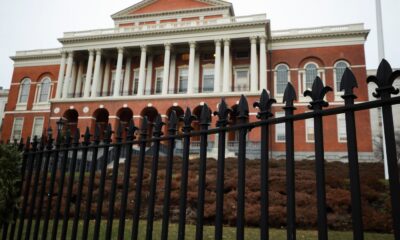Science
Scarecrows: From Ancient Guardians to Autumn Icons
Scarecrows have evolved from their origins as agricultural tools to symbols of autumn decor and horror, especially in popular culture. They appear in corn mazes, crop fields, and increasingly in horror films, often depicted as eerie figures. Agricultural scientist Rebecca Brown notes that in modern farming, scarecrows are rarely used for their intended purpose of scaring birds. Instead, they mostly serve as seasonal decorations.
Historian and folklorist James P. Leary highlights the irony in their autumnal association. Traditionally, if scarecrows were effective bird deterrents, they would have been erected in spring and utilized throughout the summer. This raises questions about their historical effectiveness and the transition from utilitarian objects to decorative figures.
Tracing the Origins of Scarecrows
The origins of scarecrows can be traced back thousands of years. Records indicate that farmers worldwide have faced challenges from seed-eating birds since ancient times. In the United States alone, birds cause over $100 million in crop damage annually. Historically, children were often employed to scare birds away, as noted by Egyptologist Walaa Mohamed Abdelhakim, who describes how children would run and make noise in fields, often finding more joy than financial gain from the task.
As farming communities grew, so did the practice of erecting scarecrow-like figures. These figures varied in design, from humanoid to abstract, and were constructed from materials such as wood, cloth, and scraps. Many early scarecrows resembled fertility deities or protective spirits, reflecting local beliefs about supernatural powers. Over time, as belief in folk magic waned, scarecrows became more practical tools for deterring pests.
The Decline of Scarecrow Effectiveness
Birds do not perceive scarecrows as genuine threats. According to avian behavior expert Susan G. Friedman, while birds may initially avoid a new scarecrow, they quickly learn that it poses no danger. This desensitization process can occur within days or weeks, depending on the species and individual bird behavior. Farmers have attempted various methods to enhance scarecrow effectiveness, including incorporating speakers for sound or designing systems that create movement.
Despite these innovations, the effectiveness of scarecrows remains limited. By the mid-20th century, the rise of industrial farming shifted focus towards more advanced methods of pest control, such as chemical deterrents and netting barriers. Brown is involved in research on “laser scarecrows,” which use laser beams to deter birds, but these can be costly, ranging from a few hundred to over $10,000 for more extensive systems. Scarecrows, in contrast, offer a low-cost alternative, which explains their continued use by some small farmers.
In the United States, even hobby farmers have largely adopted more effective techniques, such as hanging reflective materials like old CDs or mylar tape to deter birds. Leary notes that in his hometown of Rice Lake, Wisconsin, the once-common sight of scarecrows has diminished, with alternatives like recycled aluminum pie plates becoming prevalent.
Scarecrows in Culture and Tradition
Despite their dwindling utility in agriculture, scarecrows have retained a place in cultural traditions and folk rituals. Their transition from functional tools to autumn decor reflects a blend of various agrarian customs. Leary describes this evolution as a “mashup” of European practices, including the burning of scarecrows during harvest time.
British folklorist Robert Edgar observes that the handmade aesthetic of scarecrows resonates with the idea of “folk,” linking them to a nostalgic past. Their association with creatures like goblins has also contributed to their representation in horror genres, as they fit the unsettling aesthetics of spooky narratives. This connection is relatively recent, according to both Leary and Edgar, as scarecrows were originally symbols of agrarian heritage.
Communities in the United States and the United Kingdom have embraced scarecrows by organizing festivals that celebrate their artistry rather than their original purpose. One notable example is the Chappell Hill Scarecrow Festival in Texas, which has been a cherished community tradition for over 40 years. Local businesses and organizations participate by creating unique scarecrows, showcasing creativity and humor while connecting to the figures’ long history.
William Atwood, a country store owner and festival organizer, emphasizes the festival’s role in fostering community spirit. “It’s not only a celebration of the season,” he says, “but also a way for neighbors, businesses, and visitors to come together and share in a tradition.”
In summary, scarecrows have undergone a significant transformation from their ancient roots as bird deterrents to becoming emblematic of autumn and community culture. Their enduring presence in festivals and seasonal decor reflects a rich tapestry of agricultural history, folklore, and community bonding.
-

 Science1 week ago
Science1 week agoResearchers Challenge 200-Year-Old Physics Principle with Atomic Engines
-

 Politics1 week ago
Politics1 week agoNHP Foundation Secures Land for 158 Affordable Apartments in Denver
-

 Health1 week ago
Health1 week agoNeuroscientist Advocates for Flag Football Until Age 14
-

 Lifestyle1 week ago
Lifestyle1 week agoLongtime Friends Face Heartbreak After Loss and Isolation
-

 Health1 week ago
Health1 week agoFDA Launches Fast-Track Review for Nine Innovative Therapies
-

 Business1 week ago
Business1 week agoMaine Housing Inventory Surges to Post-Pandemic High
-

 Politics1 week ago
Politics1 week agoIsraeli Air Strikes in Lebanon Kill One, Wound Seven Amid Tensions
-

 World1 week ago
World1 week agoTroops to Enjoy Buffalo Chicken, Thai Curry in 2026 MREs
-

 Top Stories1 week ago
Top Stories1 week agoUnforgettable Moments: The Best Victoria’s Secret Performances
-

 World1 week ago
World1 week agoGlobal Military Spending: Air Forces Ranked by Budget and Capability
-

 Politics1 week ago
Politics1 week agoMassachusetts Lawmakers Resist Audit After Voter Mandate
-

 Business1 week ago
Business1 week agoSpirit Airlines Cuts Workforce with Furloughs for 365 Pilots









